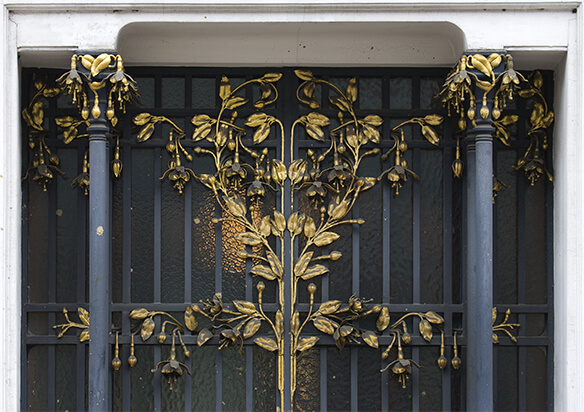
Gem of Art nouveau
The Maison Losseau presents a neo-classical white façade with a relatively austere appearance. As regards the architecture and decoration, only its metal doors, richly adorned with fuchsia flowers and leaves betray the former owner, Léon Losseau’s taste.
It is at the dawn of the 20th century that Léon Losseau developed an ambitious programme to transform this dwelling that his parents had previously acquired in 1873. In 1899, he approached Paul Saintenoy, who would create the “reappropriation” plans. A patient and devoted friend, the architect would be sure to respect his sponsor’s meticulous choices. The house would be fitted with electricity, a coal operated water vapour central heating system, electrical double hung sash windows, a private elevator, panel radiators, glass floor tiling, etc.

Gem of Art nouveau
The Maison Losseau presents a neo-classical white façade with a relatively austere appearance. As regards the architecture and decoration, only its metal doors, richly adorned with fuchsia flowers and leaves betray the former owner, Léon Losseau’s taste.
It is at the dawn of the 20th century that Léon Losseau developed an ambitious programme to transform this dwelling that his parents had previously acquired in 1873. In 1899, he approached Paul Saintenoy, who would create the “reappropriation” plans. A patient and devoted friend, the architect would be sure to respect his sponsor’s meticulous choices. The house would be fitted with electricity, a coal operated water vapour central heating system, electrical double hung sash windows, a private elevator, panel radiators, glass floor tiling, etc.

The renovation would last more than 10 years, and numerous decorators, suppliers, artists are associated with the project. A number of unique constructions would emerge from the plans drawn by Henri Sauvage, Charles Sarazin, then followed by Louis Sauvage; work we can still admire today – marble floors and mosaics with exclusive patterns, panelling and precious wooden furnishings adorned with bronze, gold enhanced stucco walls and patterns, multicolour stained and kiln worked glass windows. This exquisite décor was designed and realised by the best artists and artisans – the workshops of Emille Galle, Daum Manufacturing, or even Amalric Walter have all contributed to the project.
The mansion, which had been closed for a long time and then registered on the List of Exceptional Heritage Sites in Wallonia, thanks to the persistent request made by the Province of Hainaut and with the help of Wallonia, was the subject of a large restoration and development project. Since September 2015, its rooms have been once again made accessible to the public.
The renovation would last more than 10 years, and numerous decorators, suppliers, artists are associated with the project. A number of unique constructions would emerge from the plans drawn by Henri Sauvage, Charles Sarazin, then followed by Louis Sauvage; work we can still admire today – marble floors and mosaics with exclusive patterns, panelling and precious wooden furnishings adorned with bronze, gold enhanced stucco walls and patterns, multicolour stained and kiln worked glass windows. This exquisite décor was designed and realised by the best artists and artisans – the workshops of Emille Galle, Daum Manufacturing, or even Amalric Walter have all contributed to the project.
The mansion, which had been closed for a long time and then registered on the List of Exceptional Heritage Sites in Wallonia, thanks to the persistent request made by the Province of Hainaut and with the help of Wallonia, was the subject of a large restoration and development project. Since September 2015, its rooms have been once again made accessible to the public.



